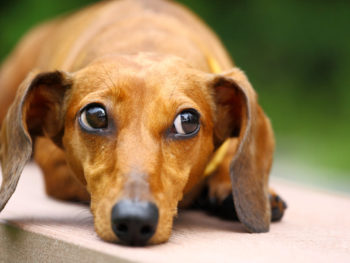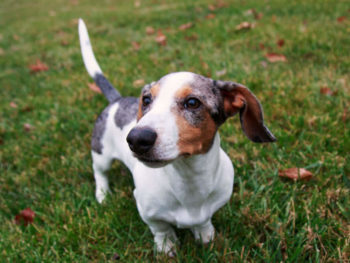Many Dachshunds scarf, or inhale, their dog food. No matter what amount they are fed, it’s gone in a couple of seconds.
It’s funny to watch, and it’s something Dachshund owners often joke about, but a dog gobbling their food quickly can actually have serious consequences.
If your dog eats their food too quickly, it can be the cause of:
- Bloat (which isn’t very common in Dachshunds but can happen)
- Choking
- Gagging
- Vomiting
- Diarrhea
- Nutrient deficiencies
- Excess weight
If your Dachshund scarfing their dog food too fast worries you because of these potential consequences, here are some things you can try to slow down their eating.
There can be serious consequences if your Dachshund eats too fast like nutrient deficiencies and choking.
9 Ways to Slow Down Your Dog’s Eating
Not all of these methods below will prevent your dog from scarfing their food but they are worth a try. Usually at least one of these things works.
Add water, another liquid, or a puree
Try mixing a tablespoon of canned (unsweetened) pumpkin in your Dachshund’s dry kibble. Mix it around so that it coats the kibble and spread it out so it sticks to the edges of the bowl.
When the food is spread out, and is slightly harder to pick up from the bowl, a dog’s eating usually slows.
While it doesn’t work for every dog, adding liquid to their dry or canned food can have a similar effect (and help keep them hydrated as a bonus).
Putting the food in water or bone broth caused a dog to have to “bob” for it like you would for an apple in the popular Halloween game.
Adding some type of liquid can slow down your Dachshund’s eating.
Both of these are quick and cheap options that could help prevent your dog from eating too fast.
Some things to try are:
- Unsweetened pumpkin puree (bonus: it helps with digestion, diarrhea, or constipation)
- Plain yogurt
- Bone broth
- Goat’s milk (plus: helps aid digestion con: can add significant extra calories so you’ll want to reduce the food amount just a little.)
Create a makeshift slow feeder
Got a smaller bowl that can fit inside your dog’s food bowl? You can turn it over and place it inside the other bowl.
Your dog will be required to nose around the bowl to get to the food.
You can accomplish this same concept by adding a rubber (non squeaking) ball to their dish.
Some Dachshunds can grow wise to this tactic and simply take the ball out of the bowl and eat at the same fervent pace but it’s worth a try.
An upturned bowl inside a bowl is a bit more difficult to remove.
Use baking supplies
If you have a baking tin, serving tray, or any long and flat container with an edge that will keep food in a contained area, you can spread your Dachshund’s food out on the surface.
This will force your dog to slow down as it sniffs around for its food.
Try putting your dog’s food in a baking tin and spreading it out.
To add another layer of engagement and entertainment, you can use a muffin tin and cover the tops with toys or balls.
Your dog will have to stop and remove the obstruction before getting to the food, which will slow down its eating.
Use food for training
There aren’t any rules that say rewards for training have to be treats.
A common practice in the dog training world is to reduce the amount of kibble a dog is eating at each meal and use the remaining amount of food for training throughout the day.
Not only will this help to keep your Dachshund a healthy weight while training, it can help keep them engaged and mentally stimulated.
Sometimes, treats are given for positive behavior that should be reinforced, like calm play, or checking in when going for a walk together.
Other times, it can be used for more fun training, like scent training.
Training doesn’t have to be boring. Some types of training are more like games.
To incorporate scent training, grab some boxes and other containers (like brown paper bags, paper towel rolls and even balled up tissue paper), hide some food in them (and possibly some other treats, that may be more smelly), and spread the boxes throughout your home or backyard.
As your Dachshund finds the containers with goodies, they will have to nose through and find their way to the food.
This activity is great for when the days are shorter and the weather is colder and you want to keep your Doxie active and mentally stimulated but can’t go outside for hikes or other activities.
Feed your Dachshund meals by hand
This is related to the one above but instead of feeding regular meals and using some of their food for training, you feed your dog their entire meal by hand, one piece of kibble or one morsel of raw food at a time.
Feeding this way ensures you can control how fast your dog is eating their meal; Wait until they done chewing or swallowing before you hand them more food.
You can control how fast your dog eats when you manually feed them.
A bonus of feeding them this way is that it can help with bonding, your dog’s willingness to pay attention to you, and make training other commands like “come” easier.
Have your Dachshund solve a puzzle
Food dispensing toys and puzzles help to make your dog solve some problems before allowing access to the yummy food inside.
A food-dispensing toy can be as simple as using a ball with a hole inside. As your dog noses the ball around on the floor, food falls out for your dog to nibble on.
Some dispensing toys are more involved than others, so if your dog quickly figures this out, you can upgrade to more challenging toys.
There are dog food puzzles too. Some puzzles have compartments that your dog has to find a way to open through using its paw or nose or mouth.
There are quite a few that can be changed to varying levels of difficulty so your dog continues to be challenged as time progresses.
Even if you have a Dachshund that doesn’t eat too quickly, using puzzles can still be a great addition to add to your routine. This mental stimulation and problem solving is helpful in keeping your dog happy, engaged, and rewarded.
Use a slow feeder
There are specific bowls on the market that can help slow your dog’s feeding.
Slow Feeders often have slits, or bumps, that your dog needs to find a way to work around to get to the food. Adding liquid creates another layer that can help to slow your dog down, too.
There are special feeders that will naturally cause your dog to eat slower.
Not all Slow Feeders are created equal. Depending on your Dachshund, they may quickly find a way to maneuver around the feeder to get to the food.
I’ve seen some dogs simply knock the bowl over with their nose and scarf the food once it was on the floor.
Looking for one with a wide base that is a bit more difficult to knock over may be a consideration when making a purchase.
There’s a mat for that
Remember shag carpeting? Imagine dropping an earring in a shag carpet and trying to find it. It would be difficult because the pile is long so things can be hidden.
You can achieve the same scenario using something called a Snuffle Mat.
These mats have pieces of fabric that have been tied to a base that’s about the size of a bath mat.
If you sprinkle your dog’s dry food on the mat, the bits of food fall between the pieces of fabric meaning your dog will have to use its sniffer to find the food and eat it.
Be consistent and recognize triggers
Sometimes Dachshunds are eating quickly because of environmental triggers. If you address the environmental trigger, it could be enough to help change the behavior of eating too quickly.
For example, if your feeding schedule is sporadic or you’re only feeding them one large meal, your dog is either unsure of when the next meal is coming or is super hungry by the time their food arrives.
Be aware of what triggers your Dachshund to eat too fast.
These two scenarios can result in your Doxie scarfing down food because they either literally don’t know when to expect the next opportunity to eat or are just too darn hungry to exhibit self control.
You might notice this if you’ve rescued a Dachshund. If the dog had a life on the streets and didn’t have consistent access to food, they frequently are ones to eat quickly.
With a regular schedule and smaller, more frequent meals, this speed eating behavior can be adjusted.
Another environmental trigger is when dogs are eating in the same room, at the same time. While not true all the time, this can sometimes result in a food eating competition of sorts.
If one Dachshund finishes before the other, it may try to nose its way into the other dog’s food.
If this happens, your other dog may try to eat more quickly in the future to protect it from being eaten by someone else. This may even result in food aggression type behavior.
Feeding your Doxies in a different space can help to prevent this behavior from occurring.
If you use individual crates for your dogs, you can feed while they are in their respective crates, which also results in your dog associating the crate with a positive (eating food).
If you don’t use dog crates, you can simply try feeding them in different rooms of the house.
The key is finding what helps prevent your dog from scarfing their food but also what works for YOU.
Does your Dachshund scarf their food? Have you tried anything to slow them down?


About the Author: Through her 17 years of owning and caring for Dachshunds, and almost 10 years researching and writing about them, JW has become a respected expert in the Dachshund community. Read more about her here.














 12 of the Most Common Health Issues in Dachshunds
12 of the Most Common Health Issues in Dachshunds


